Abstract
Stylolites are ubiquitous diagenetic products in carbonate rocks. They play a significant role in enhancing or reducing fluid flow in subsurface reservoirs. This study unravels the relationship between stylolite networks, carbonate microfacies, and the elemental geochemistry of Upper Cretaceous limestones of the Kometan Formation (shallow to moderately deep marine) in Northern Iraq. Stylolites exhibit diverse morphologies across mud- and grain-supported limestone facies. Statistical analyses of stylolite spacing, wavelength, amplitude, and their intersections and connectivity indicate that grain size, sorting, and mineral composition are key parameters that determine the geometrical properties of the stylolites and stylolite networks. Stylolites typically exhibit weak connectivity and considerable vertical spacing when hosted in packstone facies with moderate grain sorting. Conversely, mud-supported limestones, marked by poor sorting and high textural heterogeneity, host well-developed stylolite networks characterized by high amplitude and frequent intersections, indicating significant dissolution and deformation processes. Stylolites in mud-supported facies are closely spaced and present heightened amplitudes and intensified junctions, with suture and sharp-peak type. This study unveils that stylolites can potentially enhance porosity in the studied formation.
1. Introduction
The strong lateral and vertical heterogeneity of depositional textures and post-depositional diagenetic overprints make the reservoir properties of carbonate rocks difficult to predict. Therefore, assessing reservoir quality, and in particular carbonate porosity and permeability, presents significant challenges [1,2,3,4,5,6,7]. Stylolites are serrated surfaces, typically thin in cross section, that can develop due to compaction parallel to bedding planes, along which organic matter, clay minerals, and diagenetic minerals accumulate. They can also grow as a result of tectonic stress [8].
Stylolites nucleate and grow through a pressure dissolution process that begins on a sub-micron scale (grain and/or crystal interfaces). The process involves both the chemical dissolution of the rock-forming minerals and localized physical stress-induced compaction of grains along an interface that is filled with fluid [8,9]. The mineralogical heterogeneity of the rock, at least in part, controls this process by providing the necessary solubility contrast to initiate the generation of stylolite surfaces. At first glance, the proto-stylolite plane is a sharp surface that will roughen on localized, less-soluble heterogeneous material [10].
The stylolite morphology and orientation can be utilized to determine the orientation, distribution, and magnitude of overburden stress in a region at a given time [10]. The morphological parameters defining stylolites include amplitude, wavelength, spacing, and connectivity, resulting in a wide range of stylolite network architectures [9,11,12]. Several studies have demonstrated that stylolites can control fluid flow [13,14,15,16,17,18,19]. Field and laboratory observations led some authors to conclude that stylolites can operate as barriers to fluid flow [14,19,20,21,22]. However, it has also been proposed that stylolites can act as conduits for lateral fluid flow [13,14,19,23,24,25,26,27,28,29]. Preferential dissolution along existing stylolite planes has been linked to the development of localized porosity surrounding the stylolites [23] and an increase in the average diameter of pore throats [30].
There has been an increasing interest in unraveling the influence of depositional facies, and textural and compositional heterogeneity of carbonate rocks on the morphology, type, and growth of stylolites [16,20,29,31]. Another parameter that can influence the formation and evolution of stylolites in limestones is the emplacement of hydrocarbons [29,32]. Despite recent publications on this topic, the data remain scarce regarding the influence of host limestone characteristics on stylolite morphology and the resulting rock properties. Furthermore, few studies have explored the relationship between elemental composition and stylolite features. While previous research has largely focused on qualitative descriptions, our study adopts a quantitative statistical approach building on the methods of Humphrey et al. [12] to characterize stylolite networks and morphology more rigorously. This integrated methodology addresses a significant gap in stylolite-related reservoir quality assessments.
The aim of this study is to explore the relationship between stylolites and carbonate microfacies within the Upper Cretaceous Kometan Formation (Zagros Foreland Basin, Iraq; Figure 1), which forms an oil reservoir in the region. We combine the analysis of lithological parameters of the carbonates, including particle size, sorting, composition, and diagenetic features, with bulk-rock element geochemistry and quantitative morphological features of the stylolites and their networks (spacing, wavelength, amplitude, junction intensity, and connecting angle). We quantify the mutual dependence between these parameters to assess the influence of lithology and elemental geochemistry on stylolite network structures. This study specifically explores how mud-supported facies, clay content, and micrite qualitatively influence stylolite characteristics and their impact on reservoir porosity and permeability.
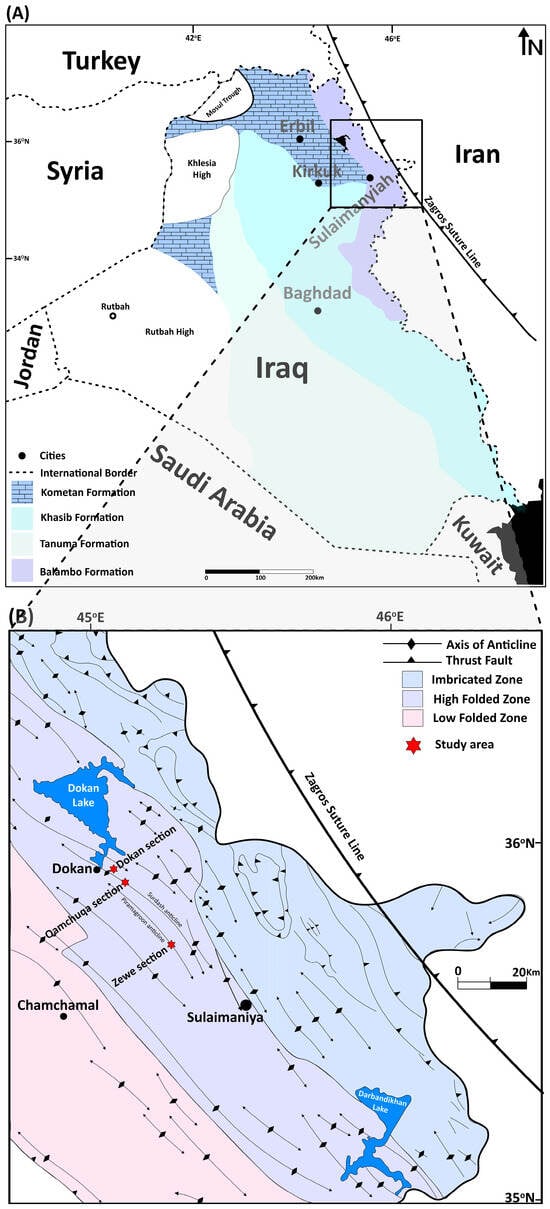
Figure 1.
(A) Map showing the location of the study in north Iraq. Modified from [33]. (B) Close view of A (black rectangle) showing the structure and tectonic subdivisions of the study area and the location of the studied sections. Modified from [34].
2. Geological Setting
The study area is located within the high folded zone of the Zagros Foreland Basin in the Kurdistan region of Iraq (Figure 1). A representative stratigraphic sequence of the study area is shown in Figure 2. Following the Hercynian Orogeny, the topography influenced the deposition of extensive upper Paleozoic strata [35]. Spanning from the Permian to the Jurassic, Kurdistan witnessed a rift phase, heralding the birth of the Neo-Tethys Ocean [36]. The Upper Permian Chia Zairi Formation represents the earliest Neo-Tethys deposits (Figure 2) [37]. Throughout the Triassic period, carbonate deposition persisted, as registered by formations like the dolomitized Geli Khana and the evaporitic Kurre Chine Formations [38,39,40,41].
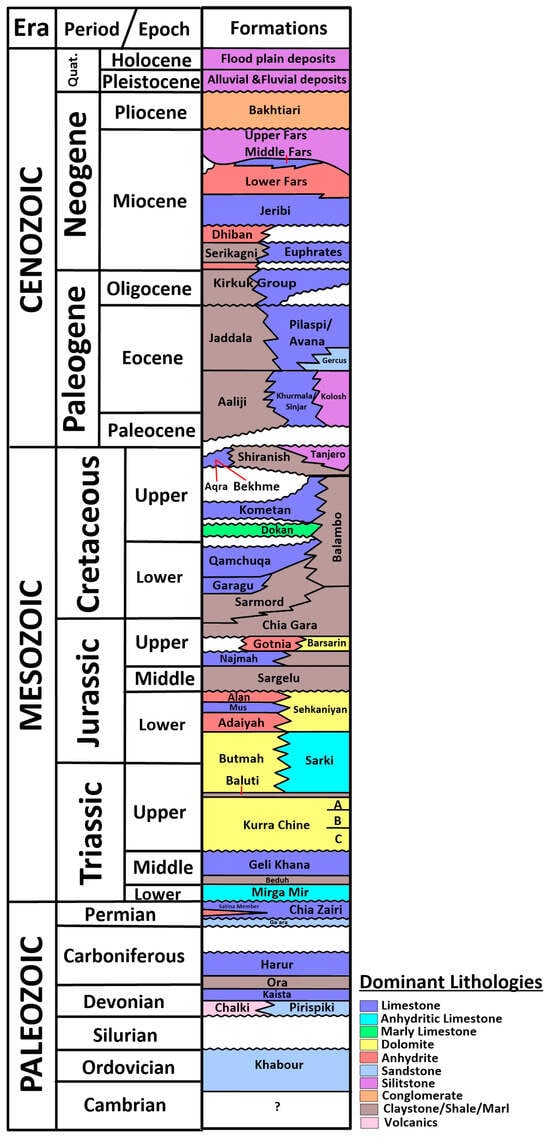
Figure 2.
Chronostratigraphic chart of the major lithostratigraphic units of the Kurdistan region in Iraq. Modified from [33].
The Triassic Baluti Formation is composed of clastic sediments sourced from the Rutbah High in western Iraq [35]. The overlying Butmah Formation is characterized by marine carbonates intercalated with evaporitic sequences formed in the Gotnia Basin. Subsequent Jurassic units include carbonate–anhydrite successions of the Adaiyah, Mus, Sargelu, and finally, Barsarin Formations [42]. The early Cretaceous was marked by fluctuating sea levels that characterized the region [33]. This period of dynamic environmental change led to the deposition of the Chia Gara Formation, in which shales predominate, alongside the deposition of carbonates in key areas. Subsequent depositional sequences, such as those of the Garagu and Sarmord Formations, reveal a gradual decline in the influence of the restricted Gotnia Basin. The Upper Cretaceous Kometan Formation is distinguished by its complex stratigraphy and significant hydrocarbon potential [33]. The Kometan Formation is extensively distributed across northern Iraq (Figure 1 and Figure 3) and was deposited during the later stages of the Turonian transgression (Figure 2). It is composed of cycles of carbonates and shales, which were deposited as a result of sea level fluctuations and varying sediment influx [43] intricately linked to tectonic activity, notably the nascent Arabia–Eurasia plate collision [33].
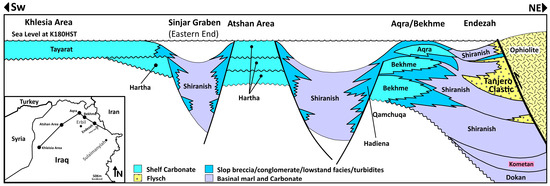
Figure 3.
Schematic Upper Cretaceous (Campanian–Maastrichtian) stratigraphic cross section across northern Iraq, illustrating segmentation of the margin into a series of structural highs and lows, and the relative thicknesses of each of the stratigraphic units. The section highlights the transition from basinal marl and carbonate deposition to carbonate shelf environments from northeast to southwest. The Kometan Formation is highlighted in pink, indicating its stratigraphic position and lateral facies variability across the structural domains. Modified from [33].
The Kometan Formation in the type locality is 36 m thick but reaches a thickness of up to 185 m in the subsurface localities. The formation comprises light grey to cream-colored, fine-grained limestones (lime mudstones and wackestones/packstones), and dolomitic limestones with abundant planktonic foraminifera [43]. The Kometan Formation was deposited in a relatively uniform marine setting characterized by six microfacies ranging from mudstone with planktonic foraminifers to well-sorted packstones rich in diverse planktonic foraminiferal assemblages. This indicates a depositional environment spanning from low-energy deeper marine (mudstone) to more energetic, open marine shelf conditions (packstones) [43]. Its deposition correlates chronologically with the latter phases of the Turonian transgression [44]. Within the confines of the Zagros Foreland Basin, the depositional facies of the Kometan Formation vary from shallow-marine shelf, restricted (oligostenginal facies) to an open-marine environment (globigerinal facies). Notably, the oligostenginal facies formed in semi-isolated basins, experiencing periodic episodes of hypersalinity [7].
The stratigraphy of the Cenozoic includes deep marine carbonate sediments (Figure 2) that record repeated depositional cycles, commencing with the regressive episodes of the early Miocene and extending into the clastic-rich Upper Fars and Bakhtiari Formations. Throughout this period, the ongoing impact of tectonic collisions and the northeastward rise of the Zagros Foreland Basin [34] played a prominent role in the depositional systems.
3. Materials and Methods
The Kometan Formation was studied and sampled in three outcrop sections called Zewe (35°44′7.171″ N, 45°14′13.930″ E), Qamchuqa (35°53′49.472″ N, 45°0′48.324″ E), and Dokan (35°56′37.197″ N, 44°58′45.385″ E) (Figure 1). The Kometan Formation thickness is as follows for each section: 96 m for Zewe, 63 m for Qamchuqa, and 65 m for Dokan. The sections were studied bed by bed by gathering data, including bed thickness and geometry, sedimentary structures, and rock composition, texture, and diagenetic features. Microfacies were studied in 50 samples, following the schemes of Dunham [45], Scholle and Ulmer-Scholle [46], and Flügel [47]. Following Humphrey et al. [12], the abundance, size, and morphological parameters of stylolites and stylolite networks were measured using 1 m × 1 m sized sampling frames to minimize the impact of vertical lithological variations. Only bedding-parallel stylolites were characterized. Outcrop sections were marked, photographed with the frame, and rectified to maintain a uniform scale and vertical-to-horizontal aspect. Each stylolite was manually delineated from the images using Golden Software Grapher v14. The stylolite spacing, amplitude, wavelength, junction angle, and type of junction were systematically measured (Figure 4). Three vertical scanlines (dashed lines, A in Figure 4) with a lateral offset of 50 cm were drawn in each frame picture perpendicular to the stylolites to measure stylolite spacing. Spacing values taken from every scanline were added up for each frame, and the heights between stylolite crossing were documented (B in Figure 4). Thus, the longest vertical stylolite spacing that can be measured with this method is one meter, but in all frames, the spacing was significantly lower than that. The central vertical scanline in each sampling frame was used to record the stylolite wavelength and amplitude. Every stylolite that crossed the scanline was documented. The wavelength was measured as the horizontal separation between the nearest two positive peaks located along the measuring line (C in Figure 4), whereas amplitudes were measured as a vertical distance between positive and negative stylolite peaks located nearest to the scanline (D in Figure 4). Selecting the nearest amplitude observations to the measuring line minimized the effects of inclination.
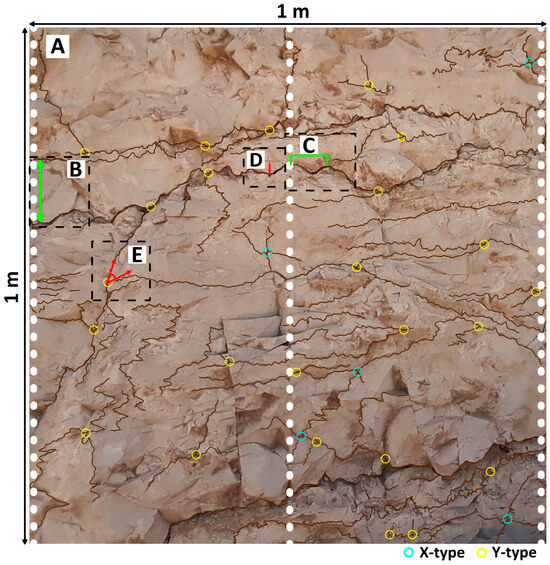
Figure 4.
Example frame size and positions of three scanlines (A) used for recording stylolite spacing (B), wavelength (C) (middle scanline), amplitude (D) (middle scanline), junction angle (E), and labeled image identifying the X-type (cyan) or Y-type (yellow) of stylolite junction.
Univariate statistics of stylolite spacing, wavelength, and amplitude were calculated and graphically represented using the software Past v4.04 [48,49]. Log-normal statistical distributions were used to fit the stylolite data, as they show the best fit. The distributions of individual parameters were matched, and the Kolmogorov–Smirnov (KS) normality testing and chi-squared tests were used to assess the goodness of fit [50]. For the KS test, a null hypothesis was chosen at the p-value lower than 0.05. The quantity of different junction forms was calculated based on the stylolite length. The techniques of Manzocchi [51] and Sanderson et al. [52] were utilized to determine fracture network connections, leading to the classification of junctions as X or Y (Figure 4). By dividing the total number of junctions by the overall stylolite length per frame, the number of junctions per facies was determined. Consequently, the ratio of stylolite junction intensity per meter (m) for each frame was obtained. This was then averaged to derive a ratio for each microfacies (Equation (1)) as follows:
where JI (/m) is the junction intensity per meter, Jt is the total amount of junctions in the sample frame, and SLt is the total stylolite length per frame. Since the sampling frame’s dimensions have an impact on the total length of the stylolite samples, SLt is not a reliable indicator of the horizontal length of stylolite networks, but it can be used to normalize junction intensities for each sampling frame for comparing junction intensities across microfacies.
JI (/m) = (Jt/(SLt))
The stylolite classification scheme of Koehn et al. [31] was employed. It includes four types: rectangular layer, seismogram pinning, suture and sharp-peak, and wave-like. The proportional frequencies of stylolite types per microfacies were calculated by adding the number of stylolite types recorded for each frame.
Depositional texture and facies, and stylolites, were analyzed and characterized using thin sections impregnated with blue-dyed epoxy resins using the image analysis approach of optical microscopy images [53,54]. A Scanning Electron Microscope (SEM), QUANTA 200 FEI equipped with an EDS detector (located at the Scientific and Technological Centres of the University of Barcelona), was utilized for detailed textural analysis. Backscatter electron (BSE) images facilitated the porosity estimation through greyscale image analysis [54]. The software ImageJ v1.52p was utilized to quantify particle areas within a specified region of interest in optical microphotographs. Mean grain size (Mz) and standard deviation or sorting (si) were calculated from the grain using the equations of Folk et al. [55].
Bulk rock samples (n = 227) from the Dokan, Zewe, and Qamchuqa sections were pulverized and analyzed by energy-dispersive X-ray fluorescence (EDXRF) spectrometry. Concentrations of 19 elements (Al, Si, P, S, K, Ca, Ti, Mn, Fe, Ni, Cu, Zn, As, Rb, Sr, Zr, Mg, Pb, and Th) were determined using a Delta Premium EDXRF spectrometer (Innov-X, Woburn, MA, USA) with a large-area Si-drift detector operating with a 2 × 120 s acquisition time at 15 kV and 40 kV beam voltage, respectively. Prior to the EDXRF analysis, the pulverized samples were enclosed in plastic containers sealed with Mylar foil. The EDXRF concentrations of the studied elements were calibrated using analytical results from EDXRF and optical emission and mass spectrometry with inductively coupled plasma (ICP-OES/MS) of 76 sample aliquots of Lower Devonian carbonates and marls of the Prague Basin, Czech Republic, which represent close lithological analogs of the Kometan Formation [56]. The EDXRF data from the Kometan Formation were converted into equivalent concentrations for ICP-MS/OES using linear and polynomial regression equations from the Prague basin data set. The regression analyses yielded high coefficients of determination (R2) ranging from 0.85 to 0.99 for all elements, indicating a high level of analytical precision of the EDXRF technique.
4. Results
4.1. Microfacies
The Kometan Formation exhibits a highly consistent argillaceous limestone and thin- to medium-bedded, fine-grained, bioturbated limestone ranging in color from light grey (lower part) to light brown (upper part). The bed thickness typically ranges between 15 and 60 cm, with thin marl laminae frequently dividing them. The formation contains numerous stylolites and locally includes chert nodules distributed parallel to the bedding planes, around which the stylolites are often concentrated (Figure 5). The Kometan Formation is severely fractured.
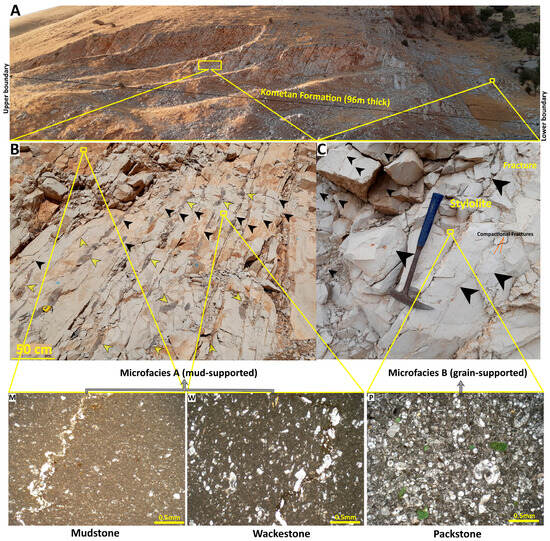
Figure 5.
Field photos of the studied formation in the Zewe section (A) and a close view of bed observations showing chert nodules (yellow arrow) and stylolites (black arrow) (B,C). Photomicrographs showing the microfacies: (M) planktonic foraminiferal mudstone, (W) planktonic foraminiferal wackestone, and (P) planktonic foraminiferal packstone with scattered glauconite (green particles).
Micro-petrography studies reveal the presence of mud-supported microfacies (mudstone and wackestone) (microfacies A) and rare, grain-supported microfacies (packstone) (microfacies B) (Figure 5). Microfacies A and B display relatively uniform allochem composition in the Zewe section. Microfacies A corresponds to mudstone –wackestone with abundant planktonic foraminifera such as Hedbergella, Heterohelix, oligosteginid foraminifera, sparse calcispheres, and sponge spicules. The micritic matrix is typically mixed with silt-sized material made of fragments of skeletal components (Figure 5). Microfacies B corresponds to moderately sorted packstones with numerous planktonic foraminifera, including Globotruncana and Dicarinella, less abundant Hedbergella and Heterohelix, scarce calcispheres, remnants of ostracod shells, and abundant grains of glauconite (Figure 5). Both microfacies indicate a distal, basinal/pelagic environment, as evidenced by the lime mudstone, wackestone, and packstone texture and the dominance of abundant planktonic foraminifera. Sedimentation in this environment was likely condensed, as indicated by the presence of glauconite grains.
4.2. Stylolite Morphology and Distribution
The stylolites in pure carbonate beds are evenly distributed both parallel to the bedding plane and vertically oriented. However, this study is restricted to bedding-parallel stylolites. Stylolites are mostly of the suture and sharp-peak type, with wave-like type. The horizontal and vertical connections of stylolites with others form complex anastomosing networks. Stylolite junctions of the Y-type are more abundant than those of the X-type, resulting in branching types. The apparent thickness of the stylolite seams, which reflects the concentration of insoluble residues including clays, can reach up to 9.5 cm (Figure 5B). The stylolites of microfacies B (Figure 5C) exhibit similar outcrop characteristics and formation patterns to those of microfacies A, yet with lower frequency and thinner stylolites (maximum = 5.4 cm).
The characterization of stylolite populations was conducted by measuring stylolite morphology at the outcrop scale to define the statistical characteristics of stylolites within the microfacies studied. The morphological parameters employed for the statistical characterization of stylolites encompass vertical spacing, amplitude, wavelength, junction type, and junction intensity (Table 1).

Table 1.
Summary of the statistical properties (mean values) of stylolite networks for microfacies A (mud-supported) and B (grain-supported).
Microfacies A has lower stylolite spacing, and thus higher stylolite frequency, than microfacies B (Figure 6). Based on quantitative measurements, nearly 50% of measured stylolite spacings in microfacies A are in the range of 7 to 74 mm, while 40% are in the range of 94 to 776 mm. Most spacing values (60%) in this microfacies range between 29 and 147 mm. The highest spacing frequency of microfacies A in total frequency numbers (683) equals 68 (mode = 27 mm, 10% of total). In comparison, 50% of the recorded measurements in microfacies B show a progressive increase from 9 to 94 mm, while 40% of the spacing ranges from 119 to 776 mm. Most of the spacings (60%) between stylolites in this microfacies vary from 37 to 190 mm. Ten percent of the total measurements are between 975 and 1225 mm, resulting in a maximum frequency of 43 out of 424 measurements (mode = 30 mm, 6% of the total). In microfacies A, there are a total of 364 measurements, and the wavelength exhibits a mode of 331 mm (73 measurements, 20% of the total). Fifty percent of the measured data ranges from 38 to 200 mm. Microfacies B, in contrast, has a shorter wavelength compared to A, with approximately more than half of the recorded values falling within the 31 to 166 mm range. The mode equals 373 mm, constituting 22% of the total measurements (244). Regarding amplitude, microfacies A shows the largest values (617 mm) and the higher mean value (66 mm) (Table 1, Figure 6). The minimum value recorded in this microfacies is 20 mm. Contrary to microfacies A, the maximum amplitude recorded in microfacies B is 28 mm. The mode value of the amplitude for both microfacies is equal to 5 mm (35% of the total amplitude of 359 measurements) and 7 mm, respectively (32% of the total amplitude of 242 measurements).
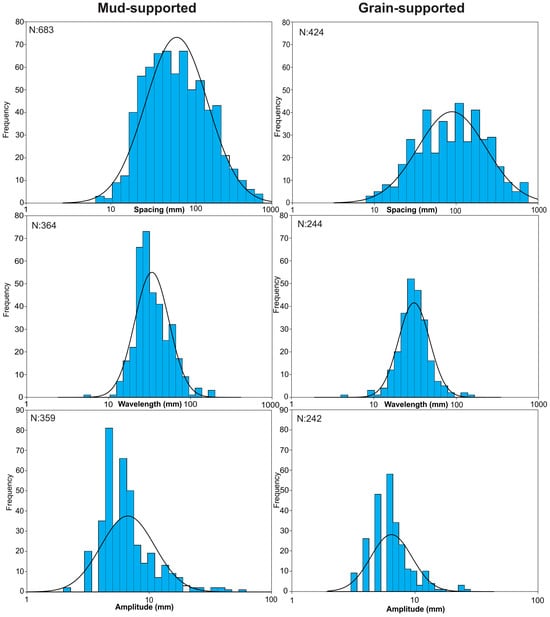
Figure 6.
Histograms showing the log-normal distribution of stylolite pores, wavelength, and amplitude observations for microfacies A (mud-supported) and B (grain-supported).
According to the classification of Koehn et al. [31], the suture, sharp-peak, and simple wave-like stylolite types dominate in the Kometan Formation (Figure 7). Stylolites of the suture and sharp-peak type constitute about 55% of the stylolites identified in microfacies A and B. Simple wave-like type stylolites represent about 43% and 44% of the stylolites found in microfacies A and B, respectively. Rectangular layer-type stylolites exhibit the lowest occurrence among various stylolite morphologies, with proportions of 0.5% and 0.1% for microfacies A and B, respectively, while those of the seismogram pinning type are absent.
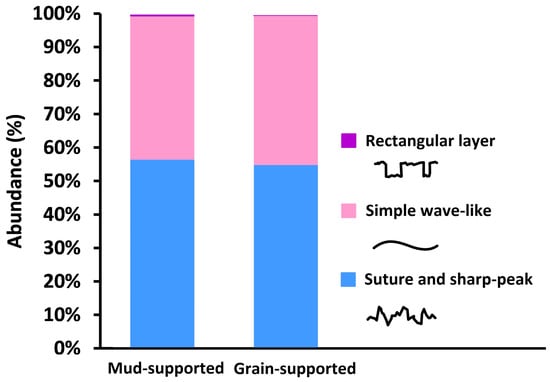
Figure 7.
Stylolite types (%) according to Koehn et al. [31] classification in mud-supported (mudstone and wackestone) and grain-supported (packstone) lithofacies.
The statistical analysis of stylolite distribution (null hypothesis rejected at p-values < 0.05) indicates that their spacing, amplitude, and wavelength are accurately represented by log-normal distributions (Figure 6 and Figure 8). Utilizing a log-normal distribution of the stylolite spacing resulted in chi-squared values ranging from 22 to 32, indicating a diminished goodness of fit. The KS test findings with a p-value exceeding 0.05 suggest a stronger level of agreement between the fitted distribution and the stylolite dataset, indicating a higher degree of goodness of fit. The p-values for both microfacies of spacing measurement for the log-normal distribution are found to be greater than 0.05 (Figure 6 and Figure 8A).
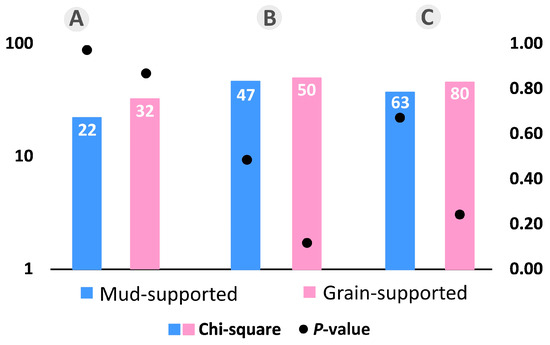
Figure 8.
Logarithmic distribution of the chi-squared and Kolmogorov–Smirnov (KS) normality tests were used to fit stylolite measurements. (A) Spacing. (B) Wavelength. (C) Amplitude.
The records of stylolite wavelength exhibit chi-squared values ranging from 47 to 50, as depicted in Figure 8B. The chi-squared and p-value exhibit higher values in microfacies A when compared to microfacies B. The p-value associated with the log-normal distribution for microfacies B remains higher than 0.05, suggesting a strong level of agreement between the observed data and the theoretical distribution. The readings of stylolite amplitude exhibit a wider range of chi-squared values (Figure 8C), ranging from 63 to 80. Additionally, the results of the KS test display a distribution of p-values above the significance threshold of 0.05, suggesting a satisfactory fit.
X- and Y-type stylolite junctions account for up to 10.6% and 89.4% of junctions in microfacies A, respectively (Figure 9a), while about 7% of microfacies B present X-type junctions. The junction intensity, measured as the number of junctions per meter (i/m), for microfacies A and B is 0.72 and 0.69 i/m, respectively (Figure 9b).
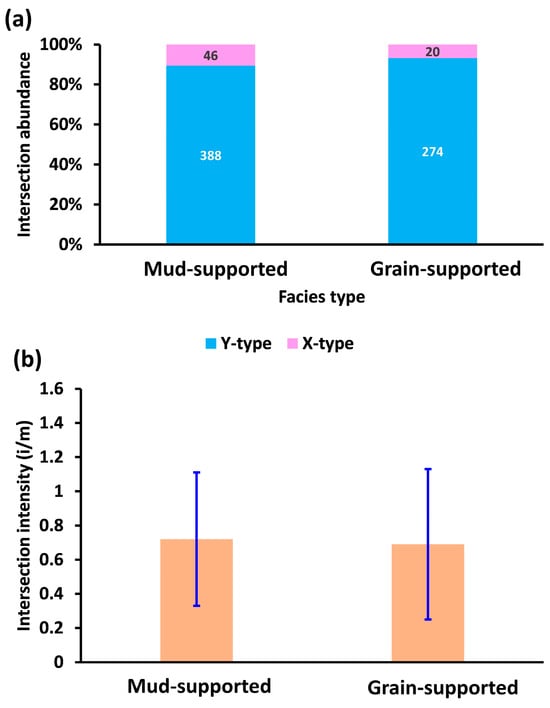
Figure 9.
(a) Stacked chart depicting the number of stylolite junctions within the microfacies under investigation. (b) Junction intensity of stylolites for each microfacies.
4.3. Present Day Stylolitic Porosity
The photomicrographs from optical microscopy (Figure 10) and BSE images (Figure 11) depict the open space within stylolite seams. The pores exhibit considerable variation in size (Figure 10). Large, interconnected, elongated, irregular pores (A, B, C, and E in Figure 10), as well as numerous scattered smaller pores have been observed. Figure 10 and Figure 11 illustrate the estimated porosity range (2% to 27%), which was calculated solely from stylolite-related pores to highlight the porosity enhancement caused by stylolite dissolution. Other types of porosity were excluded from this estimation. The carbonate dissolution along weakness planes, such as bed boundaries and thin shaly layers, facilitated the concentration of non-carbonate minerals, including clay minerals, pyrite, and phosphate, along the stylolites. This process resulted in the formation of thin vertical permeability barriers. Additionally, some stylolites were accompanied by compactional fractures, which further influenced the porosity of the rock (D, F in Figure 10 and C in Figure 5).
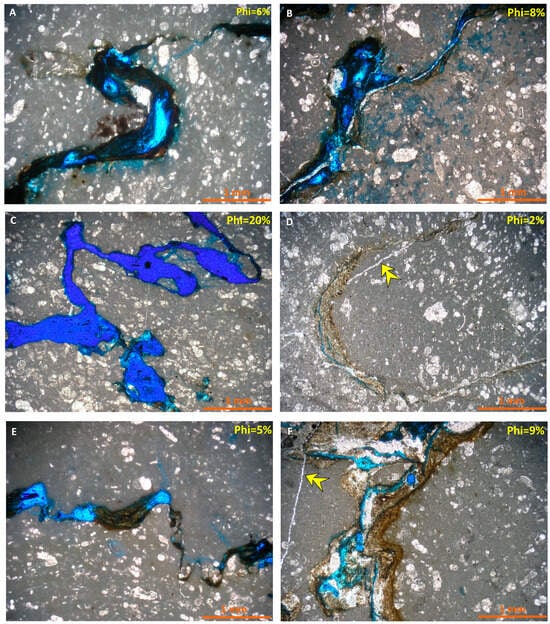
Figure 10.
Microphotographs of the Kometan Formation from the Zewe (A,B), Qamchuqa (C,D), and Dokan (E,F) sections showing stylolitic porosity. Some stylolites were accompanied by compactional fractures (indicated by yellow arrows), which further influenced the porosity of the rock.
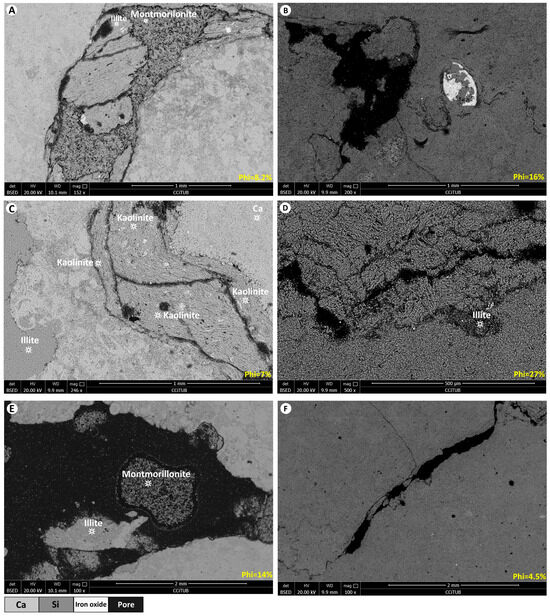
Figure 11.
Backscattered electron (BSE) images of the Qamchuqa (A,C,E) and Zewe (B,D,F) sections showing minerals within and outside stylolite seams, dissolved areas, and porosity (Phi).
4.4. Elemental Geochemistry
The elemental composition of bulk-rock samples (n = 246) is shown in Table S1 (Supplementary Material). The mean values (wt. %/ppm) and coefficients of variations (CV, %) of the element concentrations are summarized in Table 2.

Table 2.
Mean values and coefficients of variation (CV%) for major and trace element concentrations (wt.% for major elements and ppm for trace elements).
Rubidium, titanium, silicon (Figure 12), and other elements (K, Fe, Zr) show statistically significant covariance with aluminum. At the same time, these elements show negative covariance with Ca and P.
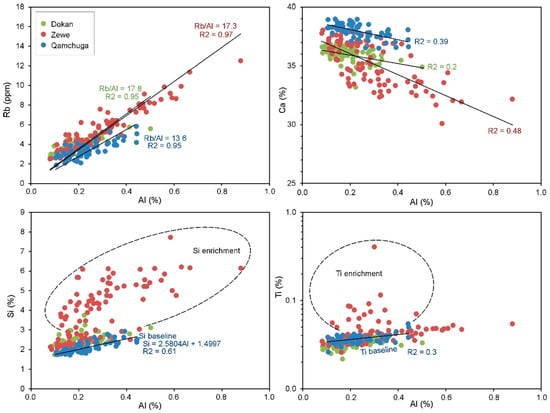
Figure 12.
Bivariate plots of element concentrations from the Kometan Formation from Dokan, Zewe, and Qamchuqa sections. Note the co-variance of lithogenic elements (Al, Rb, Ti, and Si from the Qamchuqa section) as well as the Si and Ti enrichment in the Zewe section.
The data points from different sections show distinct clusters, such as for Rb and Ca (Figure 12) and for K and Rb, indicating compositional variations in the detrital minerals between sections. For example, the Rb/Al ratio is 13.6 in the Qamchuqa section and 17.3 in the Zewe section (Figure 12). Silicon in the Qamchuqa section exhibits a notable correlation with Al (R2 = 0.61, Figure 12, Si baseline). However, significant Si enrichment is observed in the Dokan and especially in the Zewe sections (points above the baseline; Figure 12), likely due to additional biogenic sources (e.g., sponge spicules, radiolarians) and diagenetic contributions (cherts). A comparable enrichment pattern is seen for Ti, particularly in the Dokan and Zewe sections.
5. Discussion
5.1. Relationships Between Stylolite Morphology and Host Rock
To effectively analyze the relationship between stylolite types and limestone host microfacies, it is crucial to initially characterize the microfacies parameters in terms of their lithological and textural characteristics. These variables can be integrated with different stylolite morphological parameters to construct a correlation matrix (Figure 13). This matrix reveals potential linear relationships between parameters such as elemental geochemistry, stylolite morphology, and stylolite network characteristics. The host rock composition and texture exert critical control on stylolite morphology, in alignment with literature observations from various regions [12,57]. In this study, we found that mud-supported microfacies with scattered skeletal grains of variable sizes tend to develop stylolite networks characterized by high amplitude and wavelength, and relatively small vertical spacing. Conversely, grain-supported microfacies are associated with stylolites of lower amplitude and wavelength, and greater vertical spacing. These relationships are illustrated in Figure 13.
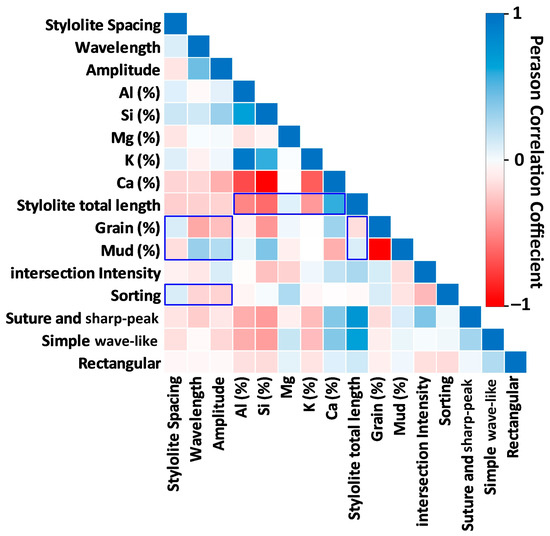
Figure 13.
Evaluation of the Pearson correlation coefficient between studied stylolite morphology and geological factors using a correlation matrix. Blue boxes show the most important connections.
The presence of micrite and clay minerals has frequently been recognized as a significant factor contributing to component solubility heterogeneity and stylolite roughening [10,13,29,58]. The presence of stylolite with high amplitudes (i.e., degree of roughening) in the mud-supported limestones is attributed to greater solubility of micrite due to the high surface area/volume ratio [29]. Stylolites with greater amplitude and wavelength are found to promote a higher number of junctions, as evidenced by favorable associations with X- and Y-type crossings and reduced vertical spacing [12] The correlation matrix reveals contrasting morphological patterns in the development of stylolites in the grain-supported limestones (Figure 13). The presence of clay minerals, as reflected by the presence of Al, Si, and K (Figure 13), contributes to variability and causes an increase in stylolite amplitude, hence facilitating the initiation and intersection of stylolites [10,13,29,58].
The presence of a bimodal grain size distribution results in an enhanced suturing process, mostly attributed to differences in the rates of dissolution and degree of resistance to pressure solution (microfacies B) [10,59,60]. The negative correlation between the content of allochems and stylolite amplitudes (Figure 13) is attributed to sorting. In a stylolitized rock, variations in the size of the allochems within the same sample (i.e., sorting) lead to increased textural heterogeneity and, as a result, greater roughness [10]. The negative correlation between sorting, amplitude, and spacing of the stylolites (Figure 13) is attributed to variations in the degree of solubility by particle size and spread variances. These heterogeneities can lead to particle pinning and disparities in solubility rates, producing favorable conditions for stylolite development and roughening [31,61]. Poor grain sorting can increase surface roughness and dissolution, which helps stylolite connect through a process called “cannibalism” where one stylolite grows by merging with a nearby one [11]. The shape of stylolites is also influenced by the type of particles present in the rock. This is because the composition of these particles results in changes in dissolution, promoting the formation and growth of stylolites. According to Wanless [58] and Tucker and Wright [62], Mg induces fluctuations in dissolution rates of the allochems.
Si and Ca exhibit complex relationships with stylolite length. While Si concentrations vary widely, our data does not reveal any clear linear trend between the Si/Ca content and total stylolite length (Figure 14). This scattered distribution shows that the influence of Si is complex and most likely controlled by other factors. A higher Si content may sometimes correlate with greater mass loss, but not consistently. Similarly, despite some concentration variation, Ca lacks a straightforward linear relationship with stylolite length (Figure 14). Higher Ca values may generally coincide with increased mass loss, but not universally. The stratigraphic geochemistry trends shown in Figure 14 indicate that pure carbonates, characterized by high Ca content, have a higher total length than less pure carbonates. These multifaceted responses emphasize the need for a more comprehensive understanding of factors influencing mass loss. Notably, Ca and Si show opposite correlations with stylolite length (Figure 13 and Figure 14). The observed scatter in Al, Si, and Ca data relative to stylolite length (Figure 14) likely reflects multiple controls, including contributions from biogenic silica, such as sponge spicules and radiolarians [59], as well as post-depositional diagenetic redistribution. These components enhance solubility contrast and promote localized stylolitization.
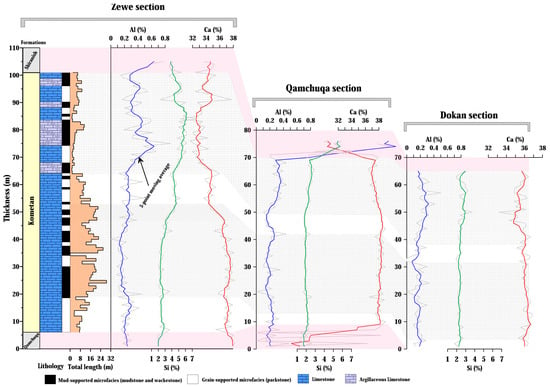
Figure 14.
Total length of stylolite along different microfacies with elemental geochemistry (Al, Si, and Ca) for the studied sections (the lower contact of Kometan Formation in the Dokan section is not exposed).
According to Wanless [58], the primary drive for the jagged or undulose waveform of stylolites (identical to suture and sharp-peak and wave-like types) is the particle size. Wanless [58] argued that undulose waveforms are more likely to form in lithologies with large particles. In this regard, Humphrey et al. [12] documented a negative correlation between the prevalence of suture and sharp-peak stylolites and wave-like stylolites in facies characterized by particle sizes greater than 2 mm. Notably, wave-like stylolites were found to predominantly form in facies with lower grain size. However, the present study reveals a nearly identical relationship (Figure 7) between the abundance of suture and sharp-peak and wave-like type stylolites in mud-supported and grain-supported microfacies. The integration of lithofacies and geochemical data reveals promising indicators for identifying stylolite “sweet spots”—zones with high stylolite connectivity that could enhance fluid migration. In particular, mud-supported microfacies (microfacies A), which exhibit higher stylolite junction intensity, greater amplitude, and closer spacing, represent potential high-connectivity zones. These facies also show elevated concentrations of clay-associated elements such as Al, Si, and K, suggesting that textural heterogeneity and clay content play a critical role in stylolite roughening and intersection. The positive correlation between Al/Si content and stylolite amplitude (Figure 13 and Figure 14) supports the inference that clay-rich, micritic lithofacies promote more complex stylolite networks. These zones may serve as preferential fluid pathways in an otherwise low-permeability matrix. Therefore, mapping geochemically enriched micritic facies with dense stylolite networks can be used as a predictive tool to guide optimal well targeting in fractured carbonate reservoirs like the Kometan Formation.
5.2. Stylolite Distribution
The log-normal distribution effectively represents the stylolite spacing, wavelength, and amplitude data in grain-supported microfacies (Figure 6 and Figure 8). The log-normal spacing distribution accurately represents all the examined microfacies [12]. This indicates that all microfacies possess a significant level of spatial heterogeneity, affecting the locations where stylolite nucleation occurs. Microfacies A exhibits comparatively lower chi-squared and higher K-S test outcomes in relation to spacing than microfacies B (Figure 8A), suggesting a potential correlation with the elevated degree of sorting observed in the rock, thus leading to more heterogeneity. It is important to mention that the log-normal distribution of stylolite spacing might also result from truncation bias, which occurs due to limitations in the sampling resolution [63].
The prominent stylolite wavelength measurements in the mud-supported limestones (Figure 6) are attributed to the presence of clay minerals, which increase the stylolitization process [61] and thereby amplitude growth. The log-normal amplitude values have been linked to an irregular growth process promoted by fluctuations in solubility and eventual grain “pinning” (i.e., the fixation of a stylolite plane to a grain or fossil) by [64] and Ebner et al. [8]. Mud-supported microfacies exhibit more robust chi-squared and K-S test outcomes regarding amplitude (Figure 8C). This is attributed to the mud-supported lithology, which is characterized by grains of varying compositions and limited sorting, explaining the weak correlation between textural heterogeneity and stylolite amplitude. The grain-supported facies exhibit a diminished level of fit in comparison to the mud-supported microfacies when evaluating the chi-squared and KS outcomes for log-normal stylolite distributions. The grain-supported facies exhibit a modest degree of sorting and display relatively low levels of compositional variation. The more homogeneous settings could consequently underscore the significance of changes in solubility on the amplitude of stylolites, as previously proposed by Ebner et al. [8]. In this context, the insufficient presence of particle “pinning” minimizes the non-linear amplitude increase.
5.3. Impact of Stylolite on Porosity
The dissolution of minerals along stylolite planes results in complex networks of channels and conduits (Figure 10 and Figure 11), which can be crucial for fluid migration, as they may provide pathways through the rock matrix that would otherwise be impermeable. In the studied areas, the uplift of the Upper Cretaceous Kometan Formation likely facilitated the circulation of acidic meteoric water, leading to the dissolution of carbonate and siliciclastic particles, thereby creating secondary porosity. The presence of kaolinite near the stylolites further supports the influence of meteoric diagenesis (Figure 11) [13]. However, care must be taken when using outcrops as direct analogs of subsurface reservoirs. The observed porosity may have a telogenetic origin (i.e., exposure to shallow meteoric diagenesis after uplift post-burial) due to exposure-related diagenetic processes, which differ from the burial diagenesis experienced by subsurface reservoirs. Stylolitization can significantly improve porosity and permeability by dissolving soluble minerals and leaving behind insoluble residues, which may compact or create void spaces. Uneven distribution of these insoluble materials can lead to interconnected pores and channels, facilitating fluid flow. While these characteristics suggest that stylolites can enhance reservoir performance, the potential telogenetic influence in outcrop settings must be considered when applying these findings to subsurface reservoirs [17]. Although porosity associated with stylolites is significant in outcrop samples, this may be exaggerated due to surface weathering and telogenetic processes [9]. Future studies incorporating subsurface core data from the Kometan Formation or comparable units are needed to quantify and contrast burial-related stylolite porosity.
To enhance the broader applicability of our findings, future studies should include comparisons with stylolites from other segments of the Zagros Fold-Thrust Belt (e.g., Ilam Formation of Dezfol Embayment) and analogous carbonate settings such as the Arabian Platform. Such comparisons would serve as valuable analogs for assessing the regional relevance and generality of the proposed model.
6. Conclusions
The statistical analysis of stylolite morphology demonstrates that their development is strongly influenced by the lithological characteristics of the host rocks, with mud-supported facies showing more pronounced stylolite networks compared to grain-supported facies. This quantitative approach proved effective in identifying the key controlling factors on stylolite development, offering a clearer understanding of how facies type governs stylolite intensity and geometry. The geochemical analysis reveals a relationship between elemental composition and stylolite formation, with elements such as silicon (Si) and aluminum (Al) correlating with stylolite development in clay-rich and siliceous environments. These geochemical signatures help to better understand the diagenetic processes involved in stylolitization and their role in reservoir quality. The enrichment of silica in certain sections points to a biogenic origin (e.g., sponge spicules, radiolarians) and diagenetic dissolution and reprecipitation process that affect both the formation of stylolites and the porosity of the reservoir rock. Higher concentrations of certain elements (e.g., silica and calcium) reflect variations in rock composition that directly influence stylolite amplitude, spacing, and network complexity.
While stylolites can enhance reservoir quality by improving localized porosity, caution should be taken when using outcrops as analogs for subsurface reservoirs, as the porosities observed in outcrops may partly reflect telogenetic origins related to surface exposure. The log-normal distribution of stylolite parameters, such as spacing and amplitude, underscores the inherent variability in their development, offering a quantitative basis for reservoir predictive modeling and characterization.
Stylolitization can act as a double-edged sword in carbonate reservoirs by enhancing fluid migration in some areas while acting as potential barriers in others, depending on the morphology and distribution of stylolites. Stylolites in the Upper Cretaceous Kometan Formation can enhance porosity through the dissolution of minerals along stylolite planes. This results in complex networks of channels that improve fluid migration in otherwise low-permeability carbonate formations. The uplift of the formation likely enhanced meteoric water circulation, leading to secondary porosity development, supported by the presence of kaolinite near stylolites, indicating meteoric diagenesis processes.
The findings emphasize the need for careful interpretation of stylolites’ role in both enhancing and potentially compartmentalizing fluid flow, which is crucial for assessing hydrocarbon recovery potential in carbonate reservoirs.
Supplementary Materials
The following supporting information can be downloaded at: https://www.mdpi.com/article/10.3390/min15070761/s1, Table S1. Bulk-rock X-ray fluorescence (XRF) concentrations (both raw data and calibrated data) from the Zewe, Qamchuga and Dokan sections, and calibration equations.
Author Contributions
Conceptualization, H.S.H., O.B., H.M., J.D.M.-M. and E.G.-R.; methodology, H.S.H. and O.B.; formal analysis, H.S.H.; investigation, H.S.H.; resources, H.S.H., O.B. and J.D.M.-M.; data curation, H.S.H., O.B. and J.D.M.-M.; writing—original draft preparation, H.S.H.; writing—review and editing, H.S.H., O.B., H.M., J.D.M.-M. and E.G.-R.; visualization, H.S.H. and O.B.; supervision, O.B., H.M., J.D.M.-M. and E.G.-R.; project administration, O.B. and H.M.; funding acquisition, O.B. and J.D.M.-M. All authors have read and agreed to the published version of the manuscript.
Funding
This research was partially funded by project number 22-15405S of the Czech Science Foundation (GACR); projects PID-2020-118999GB-I00 (Ministerio de Ciencia e Innovación/Agencia Estatal de Investigación/10.13039/501100011033), PID2021-12246NB-C22 (Ministerio de Ciencia e Innovación/Agencia Estatal de Investigación/10.13039/501100011033 and EU FEDER), and CNS2023-145382 (Ministerio de Ciencia e Innovación/Agencia Estatal de Investigación/10.13039/501100011033 and EU NextGenerationEU/PRTR); and the Group Consolidat de Recerca Geologia Sedimentària (2021 SGR-Cat 00349).
Data Availability Statement
All data are available in the manuscript. Original data of the stylolite scans are available upon request to the correspondent author.
Acknowledgments
Hussein S. Hussein extends his appreciation for the significant financial support received through the Fischer Ph.D. Scholarship Program at Palacký University Olomouc.
Conflicts of Interest
The authors declare no conflicts of interest.
References
- Lucia, F.J.; Kerans, C.; Jennings, J.W., Jr. Carbonate reservoir characterization. J. Pet. Technol. 2003, 55, 70–72. [Google Scholar] [CrossRef]
- Ehrenberg, S.N.; Nadeau, P.H. Sandstone vs. carbonate petroleum reservoirs: A global perspective on porosity-depth and porosity-permeability relationships. AAPG Bull. 2005, 89, 435–445. [Google Scholar] [CrossRef]
- Ehrenberg, S.N. Porosity destruction in carbonate platforms. J. Pet. Geol. 2006, 29, 41–52. [Google Scholar] [CrossRef]
- Harris, P.M. Delineating and quantifying depositional facies patterns in carbonate reservoirs: Insight from modern analogs. AAPG Bull. 2010, 94, 61–86. [Google Scholar] [CrossRef]
- Palermo, D.; Aigner, T.; Nardon, S.; Blendinger, W. Three-dimensional facies modeling of carbonate sand bodies: Outcrop analog study in an epicontinental basin (Triassic, southwest Germany). AAPG Bull. 2010, 94, 475–512. [Google Scholar] [CrossRef]
- Ronchi, P.; Di Giulio, A.; Ceriani, A.; Scotti, P. Contrasting fluid events giving rise to apparently similar diagenetic products; late-stage dolomite cements from the Southern Alps and central Apennines, Italy. Geol. Soc. Lond. Spec. Publ. 2010, 329, 397–413. [Google Scholar] [CrossRef]
- Rashid, F.; Glover, P.W.J.; Lorinczi, P.; Collier, R.; Lawrence, J. Porosity and permeability of tight carbonate reservoir rocks in the north of Iraq. J. Pet. Sci. Eng. 2015, 133, 147–161. [Google Scholar] [CrossRef]
- Ebner, M.; Koehn, D.; Toussaint, R.; Renard, F. The influence of rock heterogeneity on the scaling properties of simulated and natural stylolites. J. Struct. Geol. 2009, 31, 72–82. [Google Scholar] [CrossRef]
- Vandeginste, V.; John, C.M. Diagenetic implications of stylolitization in pelagic carbonates, Canterbury Basin, offshore New Zealand. J. Sediment. Res. 2013, 83, 226–240. [Google Scholar] [CrossRef]
- Koehn, D.; Ebner, M.; Renard, F.; Toussaint, R.; Passchier, C.W. Modelling of stylolite geometries and stress scaling. Earth Planet. Sci. Lett. 2012, 341, 104–113. [Google Scholar]
- Ben-Itzhak, L.L.; Aharonov, E.; Karcz, Z.; Kaduri, M.; Toussaint, R. Sedimentary stylolite networks and connectivity in limestone: Large-scale field observations and implications for structure evolution. J. Struct. Geol. 2014, 63, 106–123. [Google Scholar] [CrossRef]
- Humphrey, E.; Gomez-Rivas, E.; Neilson, J.; Martín-Martín, J.D.; Healy, D.; Yao, S.; Bons, P.D. Quantitative analysis of stylolite networks in different platform carbonate facies. Mar. Pet. Geol. 2020, 114, 104203. [Google Scholar] [CrossRef]
- Paganoni, M.; Al Harthi, A.; Morad, D.; Morad, S.; Ceriani, A.; Mansurbeg, H.; Al Suwaidi, A.; Al-Aasm, I.S.; Ehrenberg, S.N.; Sirat, M. Impact of stylolitization on diagenesis of a Lower Cretaceous carbonate reservoir from a giant oilfield, Abu Dhabi, United Arab Emirates. Sediment. Geol. 2016, 335, 70–92. [Google Scholar] [CrossRef]
- Martín-Martín, J.D.; Gomez-Rivas, E.; Gómez-Gras, D.; Travé, A.; Ameneiro, R.; Koehn, D.; Bons, P.D. Activation of stylolites as conduits for overpressured fluid flow in dolomitized platform carbonates. Geol. Soc. Lond. Spec. Publ. 2018, 459, 157–176. [Google Scholar] [CrossRef]
- Heap, M.; Reuschlé, T.; Baud, P.; Renard, F.; Iezzi, G. The permeability of stylolite-bearing limestone. J. Struct. Geol. 2018, 116, 81–93. [Google Scholar] [CrossRef]
- Toussaint, R.; Aharonov, E.; Koehn, D.; Gratier, J.P.; Ebner, M.; Baud, P.; Rolland, A.; Renard, F. Stylolites: A review. J. Struct. Geol. 2018, 114, 163–195. [Google Scholar] [CrossRef]
- Bruna, P.O.; Lavenu, A.P.; Matonti, C.; Bertotti, G. Are stylolites fluid-flow efficient features? J. Struct. Geol. 2019, 125, 270–277. [Google Scholar] [CrossRef]
- Humphrey, E.; Gomez-Rivas, E.; Koehn, D.; Bons, P.D.; Neilson, J.; Martín-Martín, J.D.; Schoenherr, J. Stylolite-controlled diagenesis of a mudstone carbonate reservoir: A case study from the Zechstein_2_Carbonate (Central European Basin, NW Germany). Mar. Pet. Geol. 2019, 109, 88–107. [Google Scholar] [CrossRef]
- Gomez-Rivas, E.; Martín-Martín, J.D.; Bons, P.D.; Koehn, D.; Griera, A.; Travé, A.; Llorens, M.G.; Humphrey, E.; Neilson, J. Stylolites and stylolite networks as primary controls on the geometry and distribution of carbonate diagenetic alterations. Mar. Pet. Geol. 2022, 136, 105444. [Google Scholar] [CrossRef]
- Burgess, C.J.; Peter, C.K. Formation, distribution, and prediction of stylolites as permeability barriers in the Thamama Group, Abu Dhabi. In Proceedings of the Middle East Oil Technical Conference and Exhibition, Bahrain, 11–14 March 1985; p. 13698. [Google Scholar]
- Finkel, E.A.; Wilkinson, B.H. Stylolitization as Source of Cement in Mississippian Salem Limestone, West-Central Indiana. AAPG Bull. 1990, 74, 174–186. [Google Scholar] [CrossRef]
- Alsharhan, A.S.; Sadd, J.L. Stylolites in Lower Cretaceous Carbonate Reservoirs, UAE. In Middle East Models of Jurassic/Cretaceous Carbonate Systems; SEPM Society for Sedimentary Geology: Tulsa, OK, USA, 2000. [Google Scholar]
- Bergen, D.V.; Carozzi, A.V. Experimentally-Simulated Stylolitic Porosity in Carbonate Rocks. J. Pet. Geol. 1990, 13, 179–192. [Google Scholar] [CrossRef]
- Carozzi, A.V.; Bergen, D.V. Stylolitic Porosity in Carbonates: A Critical Factor for Deep Hydrocarbon Production. J. Pet. Geol. 1987, 10, 267–282. [Google Scholar] [CrossRef]
- Lind, I.; Nykjaer, O.; Priisholm, S.; Springer, N. Permeability of Stylolite-Bearing Chalk. J. Pet. Technol. 1994, 46, 986–993. [Google Scholar] [CrossRef]
- Harris, N.B. Low-Porosity Haloes at Stylolites in the Feldspathic Upper Jurassic Ula Sandstone, Norwegian North Sea: An Integrated Petrographic and Chemical Mass-Balance Approach. J. Sediment. Res. 2006, 76, 444–459. [Google Scholar] [CrossRef]
- Chandra, V.; Wright, P.; Barnett, A.; Steele, R.; Milroy, P.; Corbett, P.; Geiger, S.; Mangione, A. Evaluating the Impact of a Late-Burial Corrosion Model on Reservoir Permeability and Performance in a Mature Carbonate Field Using Near-Wellbore Upscaling. Geol. Soc. Lond. Spec. Publ. 2015, 406, 427–445. [Google Scholar] [CrossRef]
- Barnett, A.J.; Wright, V.P.; Chandra, V.S.; Jain, V. Distinguishing Between Eogenetic, Unconformity-Related and Mesogenetic Dissolution: A Case Study from the Panna and Mukta Fields, Offshore Mumbai, India. Geol. Soc. Lond. Spec. Publ. 2018, 435, 67–84. [Google Scholar] [CrossRef]
- Morad, D.; Nader, F.H.; Morad, S.; Al Darmaki, F.; Hellevang, H. Impact of Stylolitization on Fluid Flow and Diagenesis in Foreland Basins: Evidence from an Upper Jurassic Carbonate Gas Reservoir, Abu Dhabi, United Arab Emirates. J. Sediment. Res. 2018, 88, 1345–1361. [Google Scholar] [CrossRef]
- Baud, P.; Rolland, A.; Heap, M.; Xu, T.; Nicolé, M.; Ferrand, T.; Reuschlé, T.; Toussaint, R.; Conil, N. Impact of Stylolites on the Mechanical Strength of Limestone. Tectonophysics 2016, 690, 4–20. [Google Scholar] [CrossRef]
- Koehn, D.; Rood, M.P.; Beaudoin, N.; Chung, P.; Bons, P.D.; Gomez-Rivas, E. A New Stylolite Classification Scheme to Estimate Compaction and Local Permeability Variations. Sediment. Geol. 2016, 346, 60–71. [Google Scholar] [CrossRef]
- Neilson, J.E.; Oxtoby, N.H.; Simmons, M.D.; Simpson, I.R.; Fortunatova, N.K. The Relationship Between Petroleum Emplacement and Carbonate Reservoir Quality: Examples from Abu Dhabi and the Amu Darya Basin. Mar. Pet. Geol. 1998, 15, 57–72. [Google Scholar] [CrossRef]
- Aqrawi, A.A.M.; Goff, J.C.; Horbury, A.D.; Sadooni, F.N. The Petroleum Geology of Iraq; Scientific Press Ltd.: Beaconsfield, UK, 2010; p. 424. [Google Scholar]
- Jassim, S.Z.; Goff, J.C. (Eds.) Geology of Iraq; DOLIN, s.r.o.: Prague, Czech Republic; Geological Society of London: London, UK, 2006. [Google Scholar]
- Martin, A.Z. Late Permian to Holocene Paleofacies Evolution of the Arabian Plate and Its Hydrocarbon Occurrences. GeoArabia 2001, 6, 445–504. [Google Scholar] [CrossRef]
- Muttoni, G.; Gaetani, M.; Kent, D.V.; Sciunnach, D.; Angiolini, L.; Berra, F.; Garzanti, E.; Mattei, M.; Zanchi, A. Opening of the Neo-Tethys Ocean and the Pangea B to Pangea A Transformation during the Permian. GeoArabia 2009, 14, 17–48. [Google Scholar] [CrossRef]
- Sharland, P.R.; Casey, D.M.; Davies, R.B.; Simmons, M.D.; Sutcliffe, O.E. Arabian Plate Sequence Stratigraphy—Revisions to SP2. GeoArabia 2001, 9, 199–214. [Google Scholar] [CrossRef]
- Szabo, F.; Kheradpir, A. Permian and Triassic Stratigraphy, Zagros Basin, South-West Iran. J. Pet. Geol. 1978, 1, 57–82. [Google Scholar] [CrossRef]
- Alavi, M. Regional Stratigraphy of the Zagros Fold-Thrust Belt of Iran and Its Proforeland Evolution. Am. J. Sci. 2004, 304, 1–20. [Google Scholar] [CrossRef]
- Sadooni, F.N.; Alsharhan, A.S. Stratigraphy, Lithofacies Distribution, and Petroleum Potential of the Triassic Strata of the Northern Arabian Plate. AAPG Bull. 2004, 88, 515–538. [Google Scholar] [CrossRef]
- Bordenave, M.L. The Origin of the Permo-Triassic Gas Accumulations in the Iranian Zagros Foldbelt and Contiguous Offshore Areas: A Review of the Palaeozoic Petroleum System. J. Pet. Geol. 2008, 31, 3. [Google Scholar] [CrossRef]
- English, J.M.; Lunn, G.A.; Ferreira, L.; Yacu, G. Geologic Evolution of the Iraqi Zagros, and Its Influence on the Distribution of Hydrocarbons in the Kurdistan Region. AAPG Bull. 2015, 99, 231–272. [Google Scholar] [CrossRef]
- Hussein, H.S.; Bábek, O.; Mansurbeg, H.; Shahrokhi, S. Outcrop-to-Subsurface Correlation and Sequence Stratigraphy of a Mixed Carbonate–Siliciclastic Ramp Using Element Geochemistry and Well Logging; Upper Cretaceous Kometan Formation, Zagros Foreland, NE Iraq. Sediment. Geol. 2024, 459, 106547. [Google Scholar] [CrossRef]
- Haddad, S.N.S.; Amin, M.A. Mid-Turonian–Early Campanian Sequence Stratigraphy of Northeast Iraq. GeoArabia 2007, 12, 135–176. [Google Scholar] [CrossRef]
- Dunham, R.J. Classification of Carbonate Rocks According to Depositional Textures. In Classification of Carbonate Rocks—A Symposium; AAPG Memoir: Tulsa, OK, USA, 1962; Volume 1, pp. 108–121. [Google Scholar]
- Scholle, P.A.; Ulmer-Scholle, D.S. A Color Guide to the Petrography of Carbonate Rocks: Grains, Textures, Porosity, Diagenesis; AAPG Memoir 77; AAPG: Tulsa, OK, USA, 2003; p. 474. [Google Scholar]
- Flügel, E.; Munnecke, A. Microfacies of Carbonate Rocks: Analysis, Interpretation and Application; Springer: Berlin/Heidelberg, Germany, 2010; p. 976. [Google Scholar]
- Hammer, Ø.; Harper, D.A. Paleontological Data Analysis; John Wiley & Sons: Hoboken, NJ, USA, 2024. [Google Scholar]
- Hammer, Ø. PAST: Paleontological statistics software package for education and data analysis. Palaeontol. Electron. 2001, 4, 9. [Google Scholar]
- Massey, F.J., Jr. The Kolmogorov-Smirnov test for goodness of fit. J. Am. Stat. Assoc. 1951, 46, 68–78. [Google Scholar] [CrossRef]
- Manzocchi, T. The connectivity of two-dimensional networks of spatially correlated fractures. Water Resour. Res. 2002, 38, 1–20. [Google Scholar] [CrossRef]
- Sanderson, D.J.; Nixon, C.W. The use of topology in fracture network characterization. J. Struct. Geol. 2015, 72, 55–66. [Google Scholar] [CrossRef]
- Grove, C.; Jerram, D.A. jPOR: An ImageJ macro to quantify total optical porosity from blue-stained thin sections. Comput. Geosci. 2011, 37, 1850–1859. [Google Scholar] [CrossRef]
- Haines, T.J.; Neilson, J.E.; Healy, D.; Michie, E.A.; Aplin, A.C. The impact of carbonate texture on the quantification of total porosity by image analysis. Comput. Geosci. 2015, 85, 112–125. [Google Scholar] [CrossRef]
- Folk, R.L.; Ward, W.C. Brazos River bar (Texas); a study in the significance of grain size parameters. J. Sediment. Res. 1957, 27, 3–26. [Google Scholar] [CrossRef]
- Bábek, O.; Kumpan, T.; Calner, M.; Šimíček, D.; Frýda, J.; Holá, M.; Ackerman, L.; Kolková, K. Redox geochemistry of the red ‘orthoceratite limestone’ of Baltoscandia: Possible linkage to mid-Ordovician palaeoceanographic changes. Sediment. Geol. 2021, 420, 105934. [Google Scholar] [CrossRef]
- Magni, S.; Martín-Martín, J.D.; Bons, P.D.; Gomez-Rivas, E. Stylolites in carbonate rocks: Morphological variability according to the host rock texture. Minerals 2025, 15, 132. [Google Scholar] [CrossRef]
- Wanless, H.R. Limestone response to stress: Pressure solution and dolomitization. J. Sediment. Res. 1979, 49, 437–462. [Google Scholar] [CrossRef]
- Railsback, L.B. Lithologic controls on morphology of pressure-dissolution surfaces (stylolites and dissolution seams) in Paleozoic carbonate rocks from the mideastern United States. J. Sediment. Res. 1993, 63, 513–522. [Google Scholar] [CrossRef]
- Andrews, L.M.; Railsback, L.B. Controls on stylolite development: Morphologic, lithologic, and temporal evidence from bedding-parallel and transverse stylolites from the US Appalachians. J. Geol. 1997, 105, 59–73. [Google Scholar] [CrossRef]
- Aharonov, E.; Katsman, R. Interaction between pressure solution and clays in stylolite development: Insights from modeling. Am. J. Sci. 2009, 309, 607–632. [Google Scholar] [CrossRef]
- Tucker, M.E.; Wright, V.P. Carbonate Sedimentology, 2nd ed.; John Wiley & Sons: Boston, MA, USA, 2009; p. 482. [Google Scholar]
- Zeeb, C.; Gomez-Rivas, E.; Bons, P.D.; Blum, P. Evaluation of sampling methods for fracture network characterization using outcrops. AAPG Bull. 2013, 97, 1545–1566. [Google Scholar] [CrossRef]
- Koehn, D.; Renard, F.; Toussaint, R.; Passchier, C.W. Growth of stylolite teeth patterns depending on normal stress and finite compaction. Earth Planet. Sci. Lett. 2007, 257, 582–595. [Google Scholar]
Disclaimer/Publisher’s Note: The statements, opinions and data contained in all publications are solely those of the individual author(s) and contributor(s) and not of MDPI and/or the editor(s). MDPI and/or the editor(s) disclaim responsibility for any injury to people or property resulting from any ideas, methods, instructions or products referred to in the content. |
© 2025 by the authors. Licensee MDPI, Basel, Switzerland. This article is an open access article distributed under the terms and conditions of the Creative Commons Attribution (CC BY) license (https://creativecommons.org/licenses/by/4.0/).